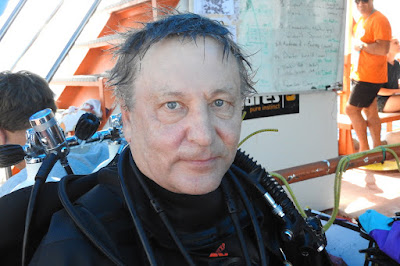Friday 16.9.2016
Today was my last day diving at Mazotos, at least for now. So, this is the last blog entry. Tomorrow is for R&R in Larnaca, High View Gardens and Mazotos Village. On Sunday I fly home.
 |
| Happy Teemu after last Mazotos dive turned out so good. |
 |
| Stella chats with Christos after giving all her birthday champagne to Mazotos wreck. |
Most of the dives today were documentation of the wreck before the excavation wraps up this weekend. My dive was again excellent, as I was just shadowing Andreas (Kr) on his photography session. At the same time I was getting a very good long last look at our achievements in preceding four weeks. What a way to finish my 21 dives at Mazotos!
 |
| Teemu and Stella |
The high point today was when one of the anchor stock lead weights was lifted. It was carefully raised into a plastic box re-enforced with metal, which was brought to surface with a lift bag, and finally lifted to M/S Queen Zenobia with a pulley. They have in earlier excavations lifted both anchor stock weights for two other anchors, but this was the first one for us.
 |
| Anchor stock weight being lifted onto M/S Queen Zenobia |
This whole setup with the fieldschool and excavation together has at least in my perspective been a big success. I wish something like this could be done also in Finland, but I doubt it. This project has had The Honor Frost Foundation to fund most of the expenses, and so far there is no such foundation in sight in Finland to chip in. Of course, none of this would not have happened without joint work of The Nautical Archaeology Society and University of Cyprus.
I am happy that I stayed on at Mazotos as a volunteer diver after the fieldschool ended. In these last two weeks I have seen how we amateur archaeologists with technical diving skills can contribute to the success of a large excavation, and how important our part is in it. It is truly important to train new volunteers with technical diving skills and the know-how on nautical archaeological fieldwork. It has been great to have the opportunity to give back right after receiving the training.
I want to give special thanks to Mark and Stella for organizing the fieldschool and the excavation at Mazotos. Also, it would not have happened without the effort of numerous people in many different fields volunteering their time and other resources. It it just amazing how many people are involved. Of course, for many the real work of conserving the finds and to processing the excavation data is just now beginning. It will take years.
I again thank Sheri from Dive-In Larnaca for posting that newspaper article in Facebook. I would not have been here without that! It is amazing, how small things can lead to big things!
 |
| Mazotos Fieldschool 2016 |
Finally, I like to thank the other 11 fieldschool students. It has been such a pleasure to know you all, and hopefully we will dive together again.
Teemu Kerola














































